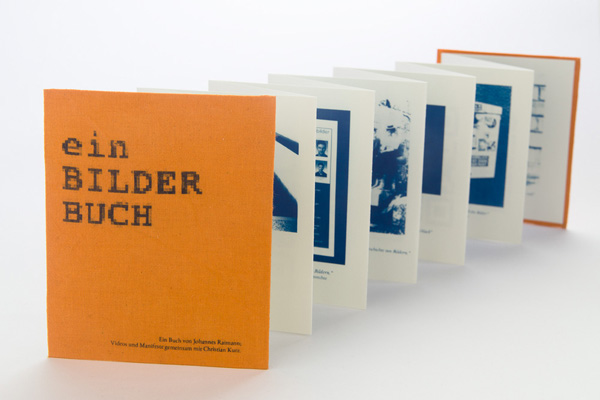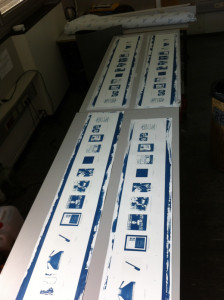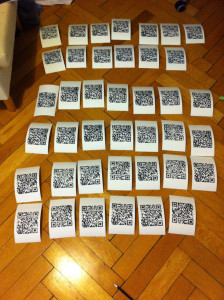Return to Theme Table of Content
“Johannes Raimann is an Austrian artist. He works and lives in vienna. His art is conceptual and analytic in an experimental way. He works with photography and photography related techniques. Most of his work is motivated by a better understanding of phenomenons he is confronted with.“

© Johannes Raimann 15 x 12 cm geschlossen, 144 x 15 cm geöffnet, 24 Seiten, Cyanotypie Linolschnitt Video, 2015
The Question
The book, ein BILDERBUCH, is a laboratory about the question “What is a Bild?” This laboratory has three stages: the cyanotype, the QR-Linocuts, and the videos. It is very important to see the book not as an answer but as an experiment and investigative process. The viewer can challenge his or her understanding of the term “Bild”. And I think the question “What is a Bild?” is essential for understanding the visual world we live in.
What Does the Term Bild Mean?
When you look at the English language you have the term “picture” and the word “image”. I use the word “picture” for the physical object and “image” for the thing that you imagine. I see this in the tradition of Louise Lawler (Lawler et al. 2013, 131).
In the German language, however, you only have the term “Bild”. Thus, I propose that both the image and the picture are like two parts in an ambiguous image in which you can see one or the other. I would identify the “Bild” as the whole ambiguous image—the picture and the image. It is also important to know that in the German language the mirror creates a “Spiegelbild,” and “Weltbild” refers to your idea of the existing world that is represented. The “Bild,” therefore, is more than the image or the picture. It is the root of both.
(Above video: interview with Johanne Raimann by Mary Gold, January 2016)
The Experiment Stages
As mentioned above, the experiment is divided in three stages. The Cyanotypes and the QR-codes are in the leporello, which has twelve pages and a hardcover. On the backside of the Cyanotypes are six QR-codes. These QR-codes are cut in linoleum and are hand printed. If the reader scans them, they lead to three videos, or the third stage of the experiment. In two of the videos, Christian Kurz and I are reciting two manifestos, while the third is a synthesis of Christian’s video and mine.

© Johannes Raimann 15 x 12 cm geschlossen, 144 x 15 cm geöffnet, 24 Seiten, Cyanotypie Linolschnitt Video, 2015
The Cyanotypes
In 1842, Sir John Herschel invented the Cyanotype process, a direct positive process where one needs a negative the size of the final image (Ware 1999, 27). To expose the picture, one uses ultraviolet light.
In a “Bild” we experience the eternal return of the same—that is, as we look at it, we see the same thing over and over again (Flusser 1997, 8). That is why I combined quotes with images in my cyanotypes. But the quotes are changed. I manipulated the quotes and replaced a central word with the term “Bild”. For example, the phrase “In the beginning was the word” was transformed into, “In the beginning was the Bild”. And this transformed quote is confronted with a picture of a sketch of a Twin-lens-reflex camera.
The cyanotype as a technique is important for me because the images are not printed—they are exposed. Therefore, they are more photographic than any printing technique could be. Furthermore, the twelve images in one row (as they are featured in the book) is a reference for analogue film.
The Linocut QR-codes
The QR-codes are cut in linoleum by hand and then hand printed on the backside of the leporello. This principle of relief printing is one of the earliest printing techniques (Timm 2004, 205). Yet, the QR-code was invented in 1994 (DENSO WAVE INCORPORATED). Consequently, you have these two very different imaging technologies that combine to create the same picture. The image, however, remains very diverse. The smartphone that is able to read QR-code has a different understanding of what an image is than that of the human eye. We understand the QR-code as a graphic appearance, as a geometrical beauty rather than a technical tool. Thus, it serves as a great example for what is meant with “Bild”. Here you have this ambiguous image that is more than just the medium or what you can see in it. This experience demonstrates what I mean when I refer to the Bilderbuch as a laboratory.
The Manifestos on Videotape
If you manage to scan one of the three functioning QR-codes, you get to one of three videos. The first manifesto is from Christian. He wrote a text in which he explains his view on the question, “What is a Bild?” In it he expresses a materialistic point of view, explaining that the “Bild” and the artwork are things—the material is necessary to carry a message. I wrote the second manifesto in which my point of view is more transcendental. I regard the “Bild” as the flicker between material, medium, message and what we recognize. Each of us speaks his manifesto directly into the camera. We used the digital look and its errors as aesthetic references to the media.
Finally, the third video is a synthesis of the other two. It depicts our manifestos mixed together and translated several times into different languages and then again into German using Google translator. This text has been read by my computer to Christian’s cell phone. This video, therefore, shows a cell phone talking with my computer. Here the content is lost. On the surface there is no message. It is the medium itself that remains after all this transformation. There is no such a thing as “sense” or “meaning” anymore. The viewer is the investigator whose job it is to create sense and make his or her own “Bild”.
To access the videos goto: http://www.johannes-raimann.at/?cat=7

© Johannes Raimann 5 x 12 cm geschlossen, 144 x 15 cm geöffnet, 24 Seiten, Cyanotypie Linolschnitt Video, 2015
References
DENSO WAVE INCORPORATED. History of QR Code | QRcode.com | DENSO WAVE. [online] Qrcode.com. Available at: http://www.qrcode.com/en/history/ [Accessed 5 Jan. 2016].
Flusser, V. (1997). Für eine Philosophie der Fotografie. Göttingen: European Photography.
Lawler, L., Buchloh, B., Foster, H., Kaiser, P. and Lütticken, S. (2013). Louise Lawler.
Mcluhan, M. (2011). Medium is the massage. Corte Madera: Gingko Press.
Timm, T. (2004). Der Diskos von Phaistos. Indogermanische Forschungen, 109.
Ware, M. (1999). Cyanotype. Bradford: National Museum of Photography.


